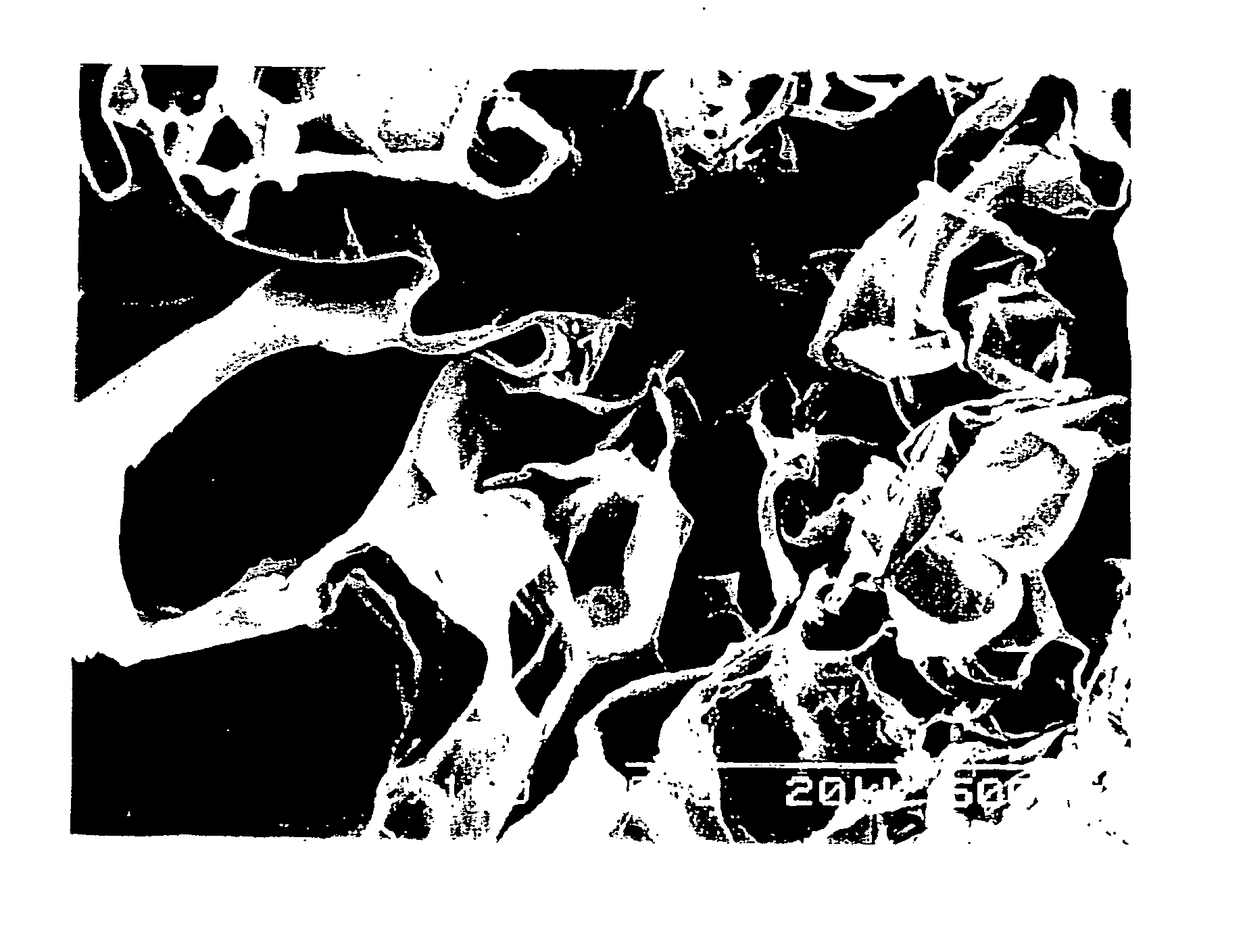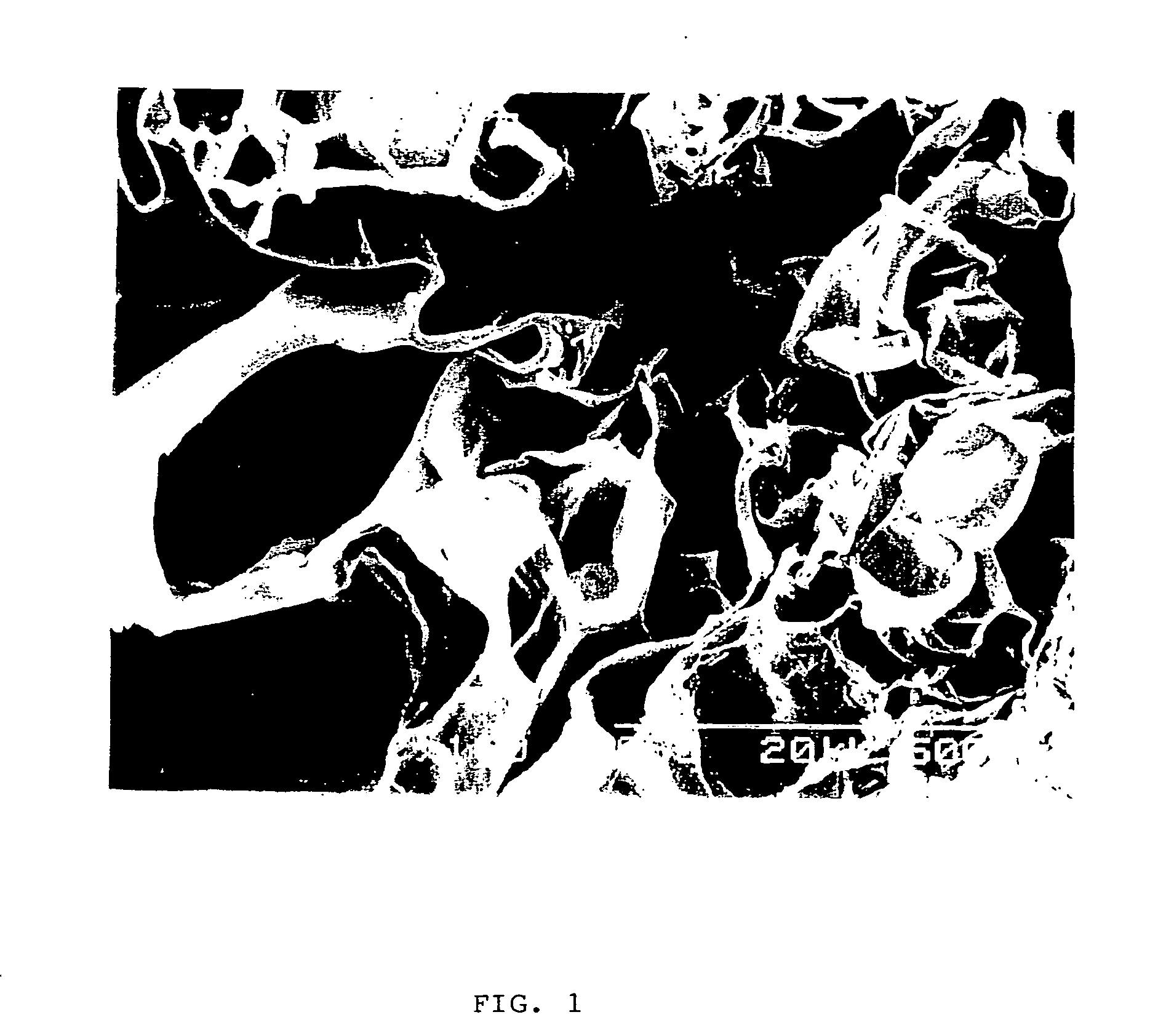Porous Body Having Biocompatibility And Method For Producing The Same
- Summary
- Abstract
- Description
- Claims
- Application Information
AI Technical Summary
Benefits of technology
Problems solved by technology
Method used
Image
Examples
example 1
[0054] 100 g of domestic silkworm cocoons after removal of pupae were immersed in 100 g of ion-exchange water and were heated at 105° C. for 30 minutes with use of an autoclave. The resultant extract was filtered using a glass filter (ADVANTEC GA-100, a product of Toyo Roshi Co., Ltd.) to remove impurities, affording about 1 wt % of an aqueous solution of sericin.
[0055] An average molecular weight of sericin obtained was measured by SDS-PAGE and was found to be about 100000.
[0056] 1.0 ml of the aqueous solution of sericin prepared above was poured into a microtube (1.5 ml) and was left standing at room temperature (about 25° C.) for 1 hour, allowing gelation of the solution to take place, followed by standing at −30° C. for 15 hours to freeze sericin gels. Next, the sericin gels were allowed to stand at room temperature for 6 hours and were melted thereby. The melt was withdrawn from the microtube, affording a porous body having a porosity of about 97% and with water retained in p...
example 2
[0061] 25 ml of the aqueous solution of sericin with a concentration of about 1 wt % prepared in Example 1 was poured into a plastic tube (50 ml) having a conical bottom, followed by the same procedure as in Example 1, to afford a porous body with water retained in pores. The porous body of sericin thus obtained was then squeezed to decrease the content of water and was dissolved again by heating. Thereafter, ion-exchange water was added to adjust the amount of the solution to 10 ml, affording an aqueous solution having a sericin concentration of about 2.5 wt %.
[0062] The procedure of Example 1 was repeated except that the aqueous solution of sericin with a concentration of about 2.5 wt % prepared above was used, affording a porous body having a porosity of about 95% and with water retained in pores.
[0063] The porous body thus obtained was evaluation for solubility (temperature stability and pH stability) in the same way in Example 1, the results of which are shown in Tables 1 and...
example 3
[0065] 640 ml of the aqueous solution of sericin with a concentration of about 1 wt % prepared in Example 1 was poured into a beaker (1 liter), followed by the same procedure as in Example 1, to afford a porous body with water retained in pores. The porous body of sericin thus obtained was then squeezed to decrease the content of water and was dissolved again by heating. Thereafter, ion-exchange water was added to adjust the amount of the solution to 80 ml, affording an aqueous solution having a sericin concentration of about 8 wt %. Further, this aqueous solution was diluted to afford 40 ml of an aqueous solution having a sericin concentration of about 2 wt % and 40 ml of an aqueous solution having a sericin concentration of about 6 wt %.
[0066] 25 ml of each of the aqueous solutions of sericin with concentrations of about 2 wt %, about 6 wt % and about 8 wt % prepared above was poured into a plastic tube (50 ml) having a conical bottom, followed by the same procedure as in Example...
PUM
| Property | Measurement | Unit |
|---|---|---|
| Fraction | aaaaa | aaaaa |
| Fraction | aaaaa | aaaaa |
| Pore size | aaaaa | aaaaa |
Abstract
Description
Claims
Application Information
 Login to View More
Login to View More - R&D Engineer
- R&D Manager
- IP Professional
- Industry Leading Data Capabilities
- Powerful AI technology
- Patent DNA Extraction
Browse by: Latest US Patents, China's latest patents, Technical Efficacy Thesaurus, Application Domain, Technology Topic, Popular Technical Reports.
© 2024 PatSnap. All rights reserved.Legal|Privacy policy|Modern Slavery Act Transparency Statement|Sitemap|About US| Contact US: help@patsnap.com









